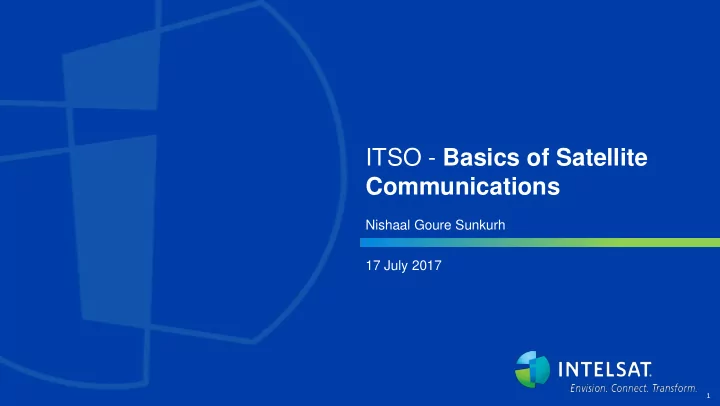

ITSO - Basics of Satellite Communications Nishaal Goure Sunkurh 17 July 2017 1
Up-Converter (U/C) • L-Band to C-Band • 950 - 1450 MHz input • 5.925 – 6.425 GHz output • Non inverting (4.900 GHz LO) • Inverting (7.375 GHz LO) • 500 MHz bandwidth • L-Band to Ku-Band • 950 - 1450 MHz input • 14.00 – 14.50 GHz output • Non inverting (LO = 13.050 GHz) • Inverting (LO = 15.450 GHz) • 500 MHz bandwidth 2
Up-Converter (U/C) • 70 MHz to C-Band • 70 ± 18 MHz input • 5.850 – 6.425 GHz output • Non inverting • 36 MHz bandwidth • 140 MHz to C-Band • 140 ± 36 MHz input • 5.850 – 6.425 GHz output • Non inverting • 72 MHz bandwidth 3
Up-Converter (U/C) • 70 MHz to Ku-Band • 70 ± 18 MHz input • 14.00 – 14.50 GHz output • Non inverting • 36 MHz bandwidth • 140 MHz to Ku-Band • 140 ± 36 MHz input • 14.00 – 14.50 GHz output • Non inverting • 72 MHz bandwidth 4
Uplink Block Diagram • Modulator / Modem • Up-Converter • Power Amplifier • Antenna • Inter Facility Link (IFL) • Fiber Optics • Co-axial cableCombiners / Splitters • Waveguide Antenna Feed Modem IFL Up-Converter IFL IFL Transmitter Simplified Uplink Block Diagram 7
Power Amplifiers • High Power Amplifiers - HPA • Solid State Power Amplifiers - SSPA • Travelling Wave Tube – TWT • Klystron Power Amplifier KPA • Including/excluding Up-conversion • Transceivers 8
Transceiver • Combination Power Supply, Up / down converter, HPA and LNA - PSU • Mounted on / at the antenna • 70 or 140 MHz or L-Band input • RF Output C/Ku/Ka-Band output • Single or dual synthesized converters • Uplink Transceiver Block Diagram • Downlink Power Supply SSPA TXIF Up-Converter RXIF Down-Converter LNA 9
Solid State Power Amplifiers • Typical output power 5 to 200 Watts • 500 MHz bandwidth • Non Linear • L-Band Up-Converter optional • Requires external 10 MHz reference • Requires Diplexer • Typically ≈ 3 dB OBO for multi carrier operation 12
Solid State Power Amplifiers • Lower Power 1- 200W • Lower OBO for multicarrier operation • Cost effective • Low maintenance • Power efficient • Susceptible to power and lightning damage 13
Travelling Tube Amplifier • Typical output power 100 – 750 Watts • 500MHz - 750 MHz bandwidth • Non Linear • Built in BUC optional • Requires 10 MHz external reference and Diplexer • ≈ 7 dB OBO for multi carrier operation • ≈ 4 dB OBO with linearizer for multi carrier operation 16
Transmitters (HPA) • HPA HIGH POWER AMPLIFIER • TRAVELING WAVE TUBE AMPLIFIER • WIDEBAND ( FULL SPECTRUM ) GREATER 500MHz • NON LINEAR • SMALL SIGNAL SUPRESSION • AMPLITUDE TRANSFER CURVE 17
Transmitters (HPA) • SMALL SIGNAL SUPRESSION • AMPLITUDE TRANSFER CURVE ( f 1 - f 2 ) - f 1 • INTERMODULATION f 1 - f 2 f 1 + f 2 f 1 f 2 18
Klystron Power Amplifier • Typical output power 1000 to 3000 Watts • Non linear • 40 or 80 MHz bandwidth • OBO ≈ 2 dB for dual carrier operation • ≈ 7 dB for multi carrier operation 20
Uplink Block Diagram • Modulator / Modem • Up-Converter • Power Amplifier • Antenna • Inter Facility Link (IFL) • Fiber Optics • Co-axial cable Combiners / Splitters • Waveguide Antenna Feed Modem IFL Up-Converter IFL IFL Transmitter Simplified Uplink Block Diagram 23
Inter Facility Linking • Co-axial cabling • Data and base band • IF • L-Band • C-Band • Ku-band 24
RF Co-axial Cabling • Important factors • Higher Frequency higher losses • Losses indirectly proportional to cable diameter • Skin effect • To a point • Losses directly proportional to frequency • Reflections – impedance mismatch • Cable damage • Water • System impedance • Connector 25
Waveguide • Used at C-Band and higher frequencies • Lower loss than co-axial cable • Types: • Rigid • Flexible, Flexible and twistable • Elyptical • Not wideband – Frequency determines dimension 26
Combiners Small Signal • Types • IF • L-band • C-Band/Ku-band • Considerations • Losses • Impedance matching • Terminating unused ports 27
Combiner - Wideband • 3dB Coupler • Co-axial • Waveguide • High power • Wideband • 3dB loss Dummy load required 28
Combiner - Filter • Co-axial • Waveguide • Variances • One port wideband • Other port narrowband • Low insertion losses 29
Technology Trends 30
Technologies Addressing your Bottom Line through the use of the latest technologies • DVB-S2 Extensions • Adaptive Coding and Modulation • Carrier in Carrier Technology • Lower Roll off factors • New Technology in Satellites • Antennas Advancements to reach new markets 31
DVB-S2 & Extensions A new standard enables true convergence • Excellent spectral efficiency: • Up to 40% bandwidth saving compared to DVB-S • Up to 2dB better than Turbo Codes • HDTV enabler • Unlike DVB-S, DVB-S2 is optimised for MPEG and IP • Allows for DTH and DTT distribution in single carrier 32
Thank you Questions ? 33
Recommend
More recommend